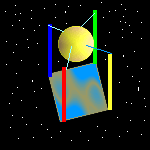
Catastrophe! Disaster! Heaven's broken! The Sky is Falling!
| Pre-Dawn Star Gazing | ||||||||||||||||||||||||
| Framework of Time | ||||||||||||||||||||||||
| Heaven on Earth | ||||||||||||||||||||||||
| Planets, the wanderers | ||||||||||||||||||||||||
| Catastrophe! Precession | ||||||||||||||||||||||||
| It's Written in the Stars | ||||||||||||||||||||||||
| About this Site | ||||||||||||||||||||||||
| Resources | ||||||||||||||||||||||||
| Feedback Form | ||||||||||||||||||||||||
| Index | ||||||||||||||||||||||||
|
The current age is the age of Pisces, because Pisces is rising with
the sun on the Vernal (Spring) Equinox. The age of Aquarius will
start when Aquarius rises with the sun. The signs of astrology are now almost a month separated from their places in astronomy. |
||||||||||||||||||||||||

|
||||||||||||||||||||||||
|
||||||||||||||||||||||||
| The Wrinkle in Time | |
|---|---|
|
Regular and reliable, predictable and so useful. People
studied, admired, imitated, and used star knowledge. They
used it as a slate to record their histories. They used
it for navigation. They used it to time seasonal activities.
Over the course of several lifetimes, the stars hold so steady. As steady as the earth itself, but the earth wobbles. A full wobble takes approximately 26,000 years. This causes the season in which certain stars appear to shift gradually over many years. The sign of the zodiac that rises with the sun on a particular day now, in 2,000 years will rise with the sun almost a month earlier. The sun will keep its scheduled alignment appointments at the monuments, but the stars that accompany it will be different ones. The wobble also causes the star at the center of the pivot to change, the world has a new center! Which of southern hemisphere stars are visible from the north also changes due to the wobble, constellations are remembered that no longer show themselves up here. The markers that once defined the seasons get out of place. Different markers define the world after a shift: a new pivot, different heralds of the seasons, once-seen stars now invisible, new stars now visible. In a sense, it is as if the old world gets swept away and replaced with a new one. New myths, realigning the stars with the seasons, are created to describe this new world and track its events. Myths also tell of the destruction of the old world, often the loss of the old world is described as a flood. Human societies change and go through tumultous upheavals as well. Times of great upheaval were blamed on the stars not staying in their old spots. This is why we speak of dis-aster-s and cat-astro-phe. Aster & astro are root words meaning star. Also of note is the phrase "the sky is falling." A very cute story about this is in the book "Secret of the Incas." Every so often, the sun gets tired, says an indigenous group of South Americans. When it gets tired it falls from the sky and causes fires and destruction, but then the people will set up 4 new pillars and tie the sun back into place, until the next time it falls... All of human knowledge has ultimately come from trying to understand nature and how we fit in, so that we can influence it in our favor when possible, and so that we can predict and prepare for those situations we can't control. We organize our knowledge by making mental models, classifying, categorizing, comparing similarities, looking for patterns. Some of this is mathematical in nature. Although now we are usually taught to use base 10 for our arithmetic, once upon a time, base 12 was more favored. Perhaps it's because thats about how many months (moon cycles) are in a year (sun cycle), but it could just be because it is so much more convenient because it divides evenly with more factors. We describe the locations of celestial objects using a 360 degree system. A solar year has 365 1/4 days. The closeness of these numbers is no coincidence. One degree is pretty close to how far the fixed stars are from where they were at the same time the day before as they go through their yearly cycle. 360 is a much simpler and more convenient number to do calculations with. It can be evenly divided by 2, 3, 4, 5, 6, 8, 9, 10, 12, 15, 18, 20, 24, 30, 36, 40, 45, 60, 72, 90, 120, and 180. Whereas 365 is only divisible by 5 and 73. Many people in their desire to live in a carefully-planned and consciously-executed, orderly well-designed universe, have thought that the year should have exactly 360 days. When people didn't realize that the precession from the wobble was just another cycle, some of them came up with theories that once the world was perfect. That once there were only 360 days and the sun did not slip backwards through the stars, and some original catastrophe caused both of these events. |
